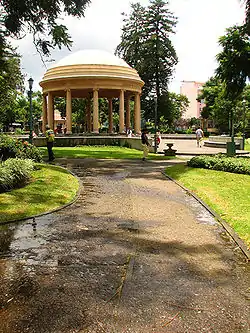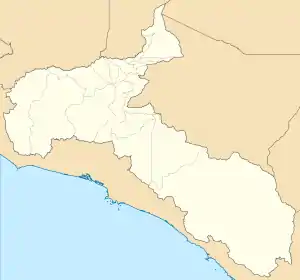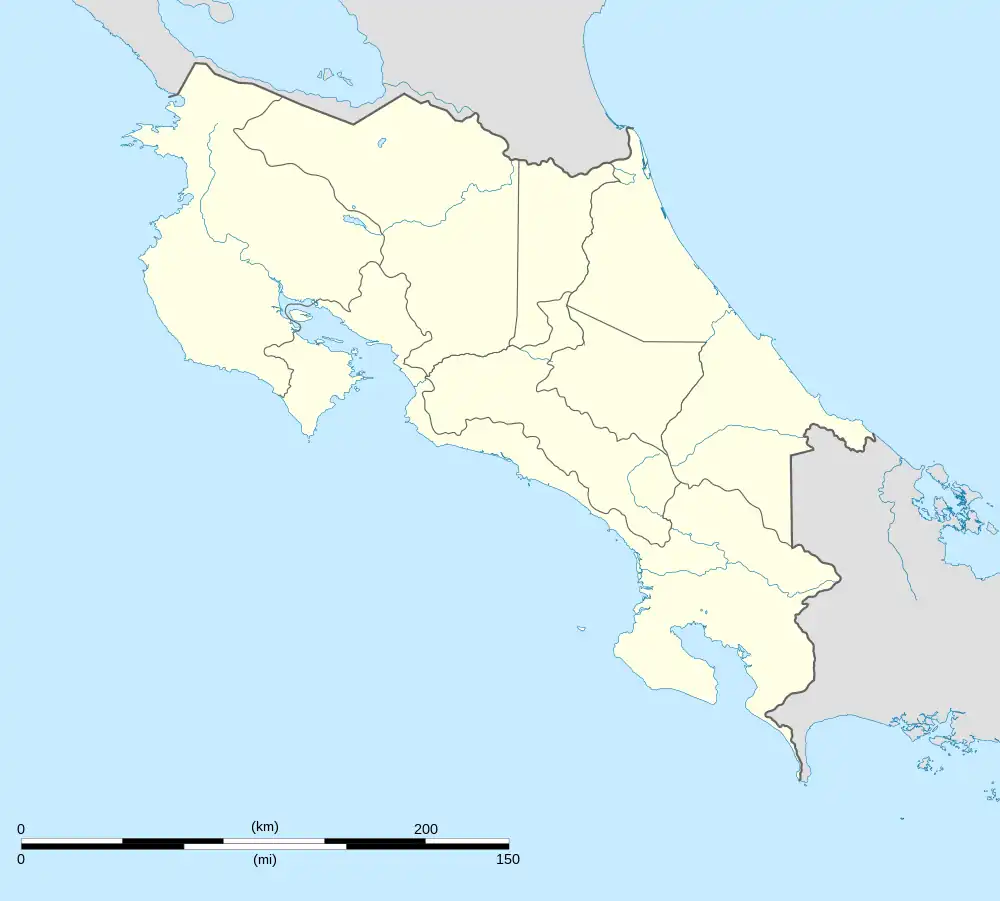San José | |
|---|---|
 Music Temple, Morazán Park | |
.svg.png.webp) Flag .svg.png.webp) Seal | |
| Etymology: From Saint Joseph | |
| Nickname: Chepe | |
San José canton | |
 San José San José canton location in San José Province  San José San José canton location in Costa Rica | |
| Coordinates: 9°56′09″N 84°06′48″W / 9.9359564°N 84.1134162°W | |
| Country | |
| Province | San José |
| Creation | 7 December 1848[1] |
| Local Celebration | March 19, Saint Joseph's Day |
| Head city | San José |
| Districts | |
| Government | |
| • Type | Municipality |
| • Body | Municipalidad de San José |
| • Mayor | Johnny Araya Monge (PLN) |
| Area | |
| • Total | 44.62 km2 (17.23 sq mi) |
| Elevation | 1,137 m (3,730 ft) |
| Population (2011) | |
| • Total | 288,054 |
| • Density | 6,500/km2 (17,000/sq mi) |
| Time zone | UTC−06:00 |
| Canton code | 101 |
| Website | www |
San José is the first canton in the province of San José in Costa Rica. It includes the national capital city of San José.[2][3]
The canton lies on a fertile plain at the eastern end of the Central Valley (Valle Central). The Virilla River and Torres River form the border on the north, while the Tiribí River marks the southern boundary. The canton encompasses San José city, composed of all its districts, albeit partially Uruca, although the Greater Metropolitan Area reaches far beyond in all directions.
The Mayor of San José Canton is Johnny Araya Monge (Partido Liberación Nacional).
Geography
San José has an area of 44.62 km²[4] and a mean elevation of 1,137 metres.[2]
Districts
The canton of San José is subdivided into the following districts:
Demographics
| Historical population | |||
|---|---|---|---|
| Census | Pop. | %± | |
| 1864 | 21,379 | — | |
| 1883 | 30,123 | 40.9% | |
| 1892 | 39,112 | 29.8% | |
| 1927 | 62,053 | 58.7% | |
| 1950 | 111,820 | 80.2% | |
| 1963 | 168,938 | 51.1% | |
| 1973 | 215,441 | 27.5% | |
| 1984 | 241,464 | 12.1% | |
| 2000 | 309,672 | 28.2% | |
| 2011 | 288,054 | −7.0% | |
|
Instituto Nacional de Estadística y Censos[5] |
|||
For the 2011 census, San José had a population of 288,054 inhabitants. [7]
Most of the population is distributed in the peripheral districts around the downtown (the districts of El Carmen, Merced, Hospital, and Catedral are known as casco central similar to a downtown or financial center, only 18% of the canton population inhabits these districts).
San José had, in 2011, 0.90 men per woman. In 2000, the province had 100% of urban population. 17.33% of its inhabitants are under ten, and 7.67% are over 65.
Transportation
Road transportation
The following road routes cover the canton:
 National Route 1
National Route 1 National Route 2
National Route 2 National Route 3
National Route 3 National Route 27
National Route 27 National Route 39
National Route 39 National Route 100
National Route 100 National Route 101
National Route 101 National Route 104
National Route 104 National Route 108
National Route 108 National Route 110
National Route 110 National Route 167
National Route 167 National Route 174
National Route 174 National Route 175
National Route 175 National Route 176
National Route 176 National Route 177
National Route 177 National Route 204
National Route 204 National Route 207
National Route 207 National Route 209
National Route 209 National Route 211
National Route 211 National Route 213
National Route 213 National Route 214
National Route 214 National Route 215
National Route 215 National Route 218
National Route 218
Rail transportation
The Interurbano Line operated by Incofer goes through this canton.
References
- ↑ Hernández, Hermógenes (1985). Costa Rica: evolución territorial y principales censos de población 1502 - 1984 (in Spanish) (1 ed.). San José: Editorial Universidad Estatal a Distancia. pp. 164–173. ISBN 9977-64-243-5. Retrieved October 5, 2020.
- 1 2 "Declara oficial para efectos administrativos, la aprobación de la División Territorial Administrativa de la República N°41548-MGP". Sistema Costarricense de Información Jurídica (in Spanish). March 19, 2019. Retrieved September 26, 2020.
- ↑ División Territorial Administrativa de la República de Costa Rica (PDF) (in Spanish). Editorial Digital de la Imprenta Nacional. March 8, 2017. ISBN 978-9977-58-477-5.
- ↑ "Área en kilómetros cuadrados, según provincia, cantón y distrito administrativo". Instituto Nacional de Estadística y Censos (in Spanish). Retrieved September 26, 2020.
- ↑ "Instituto Nacional de Estadística y Censos" (in Spanish).
- ↑ "Sistema de Consulta de a Bases de Datos Estadísticas". Centro Centroamericano de Población (in Spanish).
- ↑ "Censo. 2011. Población total por zona y sexo, según provincia, cantón y distrito". Instituto Nacional de Estadística y Censos (in Spanish). Retrieved September 26, 2020.